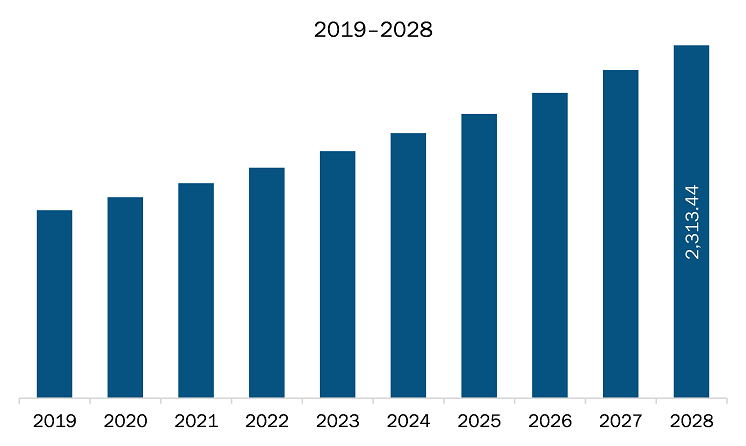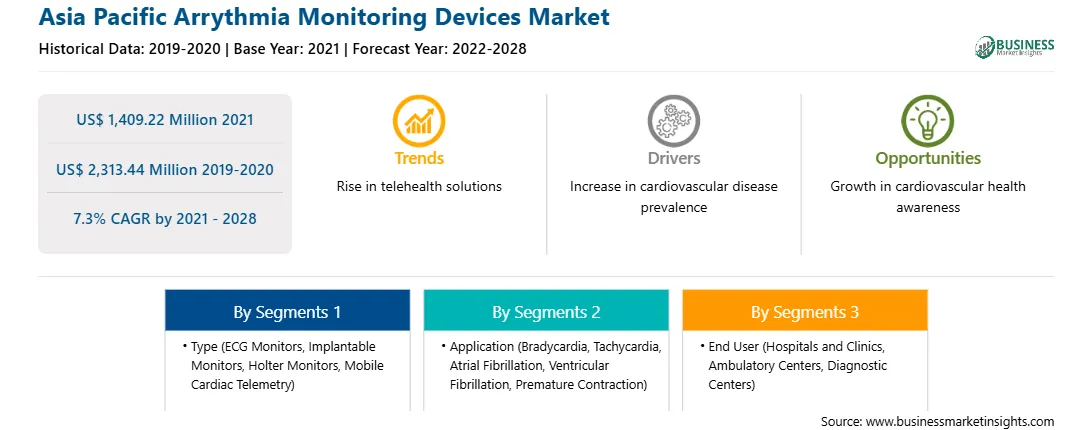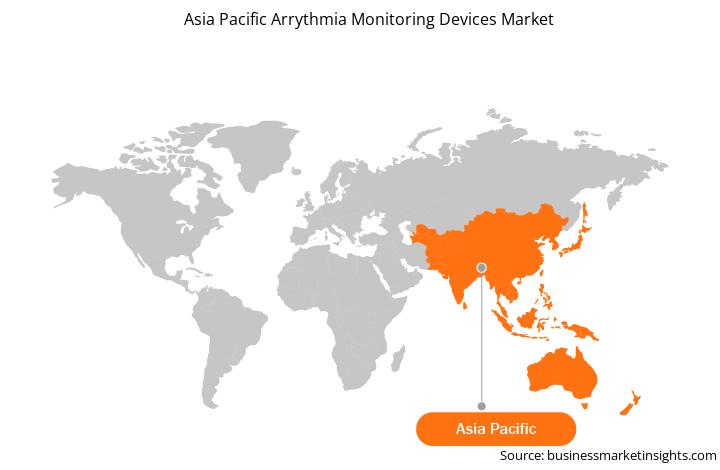Asia Pacific consists of five major countries namely China, Japan, India, Australia, and South Korea. The market is also evaluated for the rest of countries in Asia Pacific. In China, the market for arrhythmia monitoring devices is driven by the rising demand for high-tech medical devices to treat chronic diseases like cardiovascular diseases, the increasing elderly population, and product innovations. As per the prediction done by World Heart Federation, cardiovascular events like ischemic heart disease and stroke are expected to rise by 50% among the Chinese population between 2010 and 2030. Moreover, in 2017, according to the Office of the National Working Commission on Aging, the number of people of age 60 years or more was 241 million in China. Furthermore, The China National Committee on Aging (CNCA) estimated that the number of geriatric populations is expected to reach 487 million by 2050. Such rapid rise in cardiac cases and elderly population anticipated contributing to the growth of the market.Among the Chinese population, coronary heart disease (CHD) is the second leading cause of cardiovascular death. Accounting for 22% of cardiovascular deaths in urban areas and 13% in rural areas, however, mortality from CHD in China is relatively low compared with Western levels, and the burden of CHD has been increasing. According to the National Center for Biotechnology Information (NCBI), projections have been made that CVD incidence will be growing continuously, and this upward trend will continue till the next decade. Additionally, in 2017, 228,938 cardiac surgeries were reported to be performed in mainland China. Thus, the factors mentioned above are likely to propel the demand for arrhythmia monitoring devices in this country
Countries in Asia Pacific are facing challenges due to increasing incidences of COVID-19. As per the data of Worldometer, as of June 23, 2021, the Asia reported a total of 54.7 million COVID-19 cases, while in India the number of cases has been increasing and reached to 30,028,709 cases with 390,691 deaths so far. India and Japan registered considerable number of COVID-19 cases. Currently, India is the second worse hit country worldwide. Though, the government of India managed first wave of coronavirus, the conditions are continually worsening during the second wave of pandemic. Many measures have been implemented to contain the spread of COVID-19, that have resulted in significant operational disruption for many companies including in healthcare industry. Staff quarantine, supply-chain failures, and reductions in demand have generated serious complications for companies. Also, there has been a significant drop in in-patient and out-patient visits for private hospital chains. To relieve healthcare systems, many clinics have been postponing non-critical cardiac surgeries. As per a report published in the British Journal of Surgery on May 12, the number of operations cancelled in India is estimated at 48,728 per week. Moreover, medical device companies are starting to forecast large sales declines in their Chinese markets because people are staying at home. Many big medical device companies such as Philips, GE Healthcare, and Hill-Rom amongst others have predicated the decline in sales in china. Almost no elective surgeries were performed in China in February. Such activities are anticipated to have negative impact on Asia Pacific arrhythmia monitoring devices market.

Strategic insights for the Asia Pacific Arrythmia Monitoring Devices provides data-driven analysis of the industry landscape, including current trends, key players, and regional nuances. These insights offer actionable recommendations, enabling readers to differentiate themselves from competitors by identifying untapped segments or developing unique value propositions. Leveraging data analytics, these insights help industry players anticipate the market shifts, whether investors, manufacturers, or other stakeholders. A future-oriented perspective is essential, helping stakeholders anticipate market shifts and position themselves for long-term success in this dynamic region. Ultimately, effective strategic insights empower readers to make informed decisions that drive profitability and achieve their business objectives within the market.

| Report Attribute | Details |
|---|---|
| Market size in 2021 | US$ 1,409.22 Million |
| Market Size by 2028 | US$ 2,313.44 Million |
| CAGR (2021 - 2028) | 7.3% |
| Historical Data | 2019-2020 |
| Forecast period | 2022-2028 |
| Segments Covered |
By Type
|
| Regions and Countries Covered | Asia-Pacific
|
| Market leaders and key company profiles |
|
The geographic scope of the Asia Pacific Arrythmia Monitoring Devices refers to the specific areas in which a business operates and competes. Understanding local distinctions, such as diverse consumer preferences (e.g., demand for specific plug types or battery backup durations), varying economic conditions, and regulatory environments, is crucial for tailoring strategies to specific markets. Businesses can expand their reach by identifying underserved areas or adapting their offerings to meet local demands. A clear market focus allows for more effective resource allocation, targeted marketing campaigns, and better positioning against local competitors, ultimately driving growth in those targeted areas.

The arrythmia monitoring devices market in APAC is expected to grow from US$ 1,409.22 million in 2021 to US$ 2,313.44 million by 2028; it is estimated to grow at a CAGR of 7.3% from 2021 to 2028. Market consolidations, Changes or shift in technology-related trends encourage players to develop innovative devices. Recent developments in HIPPA-compliant technology have enabled secured data transmission throughout the monitoring period without delays. Emerging technologies are providing effective alternatives for traditional Holter monitors that create alerts for patients with a high risk of cardiac arrhythmia. Hence, continuous remote monitoring capabilities of these devices facilitating long-term, uninterrupted cardiac rhythm management are adding to their popularity. The mobile cardiac telemetry (MCT) system is an innovative product that assist in monitoring heart conditions of cardiac patients. Patients carry the tiny sensor and monitor throughout the day, and whenever, a cardiac event occurs, MCT sends the data to a central system for analysis and reaction. The system generates a report and shares it with the patient's physician, along with graphs and trends, for further actions. The abilities of MCT systems to analyze every heartbeat with little interference to the patient's normal days and to initiate an immediate emergency response as needed make them one of the most attractive choices cardiac monitoring. This is bolstering the growth of the arrythmia monitoring devices market.
In terms of type, the holter monitors segment accounted for the largest share of the APAC arrythmia monitoring devices market in 2020. In terms of application, the atrial fibrillation segment held a larger market share of the arrythmia monitoring devices market in 2020. Further, the hospitals and clinics segment held a larger share of the market based on end user in 2020.
A few major primary and secondary sources referred to for preparing this report on arrythmia monitoring devices market in APAC are company websites, annual reports, financial reports, national government documents, and statistical database, among others. Major companies listed in the report are Abbott
The Asia Pacific Arrythmia Monitoring Devices Market is valued at US$ 1,409.22 Million in 2021, it is projected to reach US$ 2,313.44 Million by 2028.
As per our report Asia Pacific Arrythmia Monitoring Devices Market, the market size is valued at US$ 1,409.22 Million in 2021, projecting it to reach US$ 2,313.44 Million by 2028. This translates to a CAGR of approximately 7.3% during the forecast period.
The Asia Pacific Arrythmia Monitoring Devices Market report typically cover these key segments-
The historic period, base year, and forecast period can vary slightly depending on the specific market research report. However, for the Asia Pacific Arrythmia Monitoring Devices Market report:
The Asia Pacific Arrythmia Monitoring Devices Market is populated by several key players, each contributing to its growth and innovation. Some of the major players include:
The Asia Pacific Arrythmia Monitoring Devices Market report is valuable for diverse stakeholders, including:
Essentially, anyone involved in or considering involvement in the Asia Pacific Arrythmia Monitoring Devices Market value chain can benefit from the information contained in a comprehensive market report.